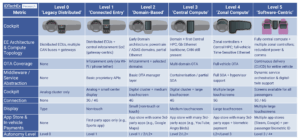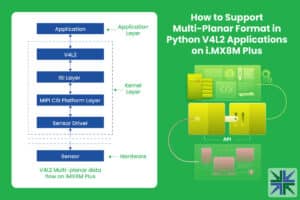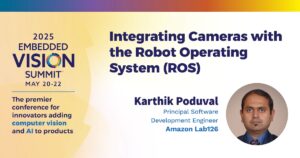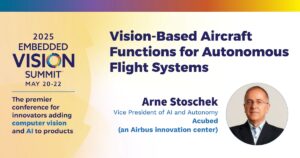Software for Embedded Vision

GenAI Firsts: Redefining What’s Possible At the Edge
This blog post was originally published at Qualcomm’s website. It is reprinted here with the permission of Qualcomm. How our pioneering research and leading proof-of-concepts are paving the way for generative AI to scale What you should know: Qualcomm AI Research is pioneering research and inventing novel techniques to deliver efficient, high-performance GenAI solutions. Our

“Improving Worksite Safety with AI-powered Perception,” a Presentation from Arcure
Sabri Bayoudh, Chief Innovation Officer at Arcure, presents the “Improving Worksite Safety with AI-powered Perception” tutorial at the May 2025 Embedded Vision Summit. In this presentation, Bayoudhl explores how embedded vision is being used in industrial applications, including vehicle safety and production. He highlights some of the challenging requirements of… “Improving Worksite Safety with AI-powered

Software-defined Vehicles: Built For Users, or For the Industry?
SDV Level Chart: IDTechEx defines SDV performance using six levels. Most consumers still have limited awareness of the deeper value behind “software-defined” capabilities The concept of the Software-Defined Vehicle (SDV) has rapidly emerged as a transformative trend reshaping the automotive industry. Yet, despite widespread use of the term, there remains significant confusion around its core

How to Support Multi-planar Format in Python V4L2 Applications on i.MX8M Plus
This blog post was originally published at e-con Systems’ website. It is reprinted here with the permission of e-con Systems. The default Python V4L2 library module contains critical details related to the V4L2 capture method. Learn how to implement basic definitions (missing the default library module) and capture images in the V4L2 multi-planar format. Python

“Introduction to Designing with AI Agents,” a Presentation from Amazon Web Services
Frantz Lohier, Senior Worldwide Specialist for Advanced Computing, AI and Robotics at Amazon Web Services, presents the “Introduction to Designing with AI Agents” tutorial at the May 2025 Embedded Vision Summit. Artificial intelligence agents are components in an AI system that can perform tasks autonomously, making decisions and taking actions… “Introduction to Designing with AI

Upcoming Presentation and Demonstrations Showcase Autonomous Mobile Robots and Machine Vision
On Wednesday, October 15 from 11:45 AM – 12:15 PM PT, Alliance Member company eInfochips will deliver the presentation “Real-time Vision AI System on Edge AI Platforms” at the RoboBusiness and DeviceTalks West 2025 Conference in Santa Clara, California. From the event page: This session presents a real-time, edge-deployed Vision AI system for automated quality

Into the Omniverse: World Foundation Models Advance Autonomous Vehicle Simulation and Safety
This blog post was originally published at NVIDIA’s website. It is reprinted here with the permission of NVIDIA. AI and OpenUSD accelerate safe, scalable autonomous vehicle development by enabling simulation-first approaches. Editor’s note: This blog is a part of Into the Omniverse, a series focused on how developers, 3D practitioners and enterprises can transform their

“Integrating Cameras with the Robot Operating System (ROS),” a Presentation from Amazon Lab126
Karthik Poduval, Principal Software Development Engineer at Amazon Lab126, presents the “Integrating Cameras with the Robot Operating System (ROS)” tutorial at the May 2025 Embedded Vision Summit. In this presentation, Poduval explores the integration of cameras within the Robot Operating System (ROS) for robust embedded vision applications. He delves into… “Integrating Cameras with the Robot

LLiMa: Real-time Edge Generative AI Under 10W, Built for You
This blog post was originally published at SiMa.ai’s website. It is reprinted here with the permission of SiMa.ai. LLiMa represents a paradigm shift in physical AI deployment that fundamentally changes how enterprises approach GenAI integration, enabling real Physical AI. While competitors typically offer pre-optimized models that were manually tuned for specific hardware configurations, LLiMa takes

“Using Computer Vision for Early Detection of Cognitive Decline via Sleep-wake Data,” a Presentation from AI Tensors
Ravi Kota, CEO of AI Tensors, presents the “Using Computer Vision for Early Detection of Cognitive Decline via Sleep-wake Data” tutorial at the May 2025 Embedded Vision Summit. AITCare-Vision predicts cognitive decline by analyzing sleep-wake disorders data in older adults. Using computer vision and motion sensors coupled with AI algorithms,… “Using Computer Vision for Early

How Synthetic Datasets are Revolutionizing AI Training Across Industries
This blog post was originally published at Geisel Software’s Symage website. It is reprinted here with the permission of Geisel Software. Synthetic data is becoming increasingly integral to AI and analytics, with many projects now incorporating these datasets. While synthetic data generated using generative AI techniques offers valuable insights, simulation-based synthetic datasets enhance this process

“AI-powered Scouting: Democratizing Talent Discovery in Sports,” a Presentation from ai.io
Jonathan Lee, Chief Product Officer at ai.io, presents the “AI-powered Scouting: Democratizing Talent Discovery in Sports,” tutorial at the May 2025 Embedded Vision Summit. In this presentation, Lee shares his experience using AI and computer vision to revolutionize talent identification in sports. By developing aiScout, a platform that enables athletes… “AI-powered Scouting: Democratizing Talent Discovery

Capgemini Leverages Qualcomm Dragonwing Portfolio to Enhance Railway Monitoring with Edge AI
This blog post was originally published at Qualcomm’s website. It is reprinted here with the permission of Qualcomm. AI device powered by Qualcomm Dragonwing boosts productivity and reduces cloud dependence in Capgemini’s monitoring application for grade crossings Capgemini moved from their previous hardware solution to an edge AI device powered by the Qualcomm® Dragonwing™ QCS6490

“Vision-based Aircraft Functions for Autonomous Flight Systems,” a Presentation from Acubed (an Airbus Innovation Center)
Arne Stoschek, Vice President of AI and Autonomy at Acubed (an Airbus innovation center), presents the “Vision-based Aircraft Functions for Autonomous Flight Systems” tutorial at the May 2025 Embedded Vision Summit. At Acubed, an Airbus innovation center, the mission is to accelerate AI and autonomy in aerospace. Stoschek gives an… “Vision-based Aircraft Functions for Autonomous

“Edge AI and Vision at Scale: What’s Real, What’s Next, What’s Missing?,” An Embedded Vision Summit Expert Panel Discussion
Sally Ward-Foxton, Senior Reporter at EE Times, moderates the “Edge AI and Vision at Scale: What’s Real, What’s Next, What’s Missing?” Expert Panel at the May 2025 Embedded Vision Summit. Other panelists include Chen Wu, Director and Head of Perception at Waymo, Vikas Bhardwaj, Director of AI in the Reality… “Edge AI and Vision at

Hot Topics at Hot Chips: Inference, Networking, AI Innovation at Every Scale — All Built on NVIDIA
This blog post was originally published at NVIDIA’s website. It is reprinted here with the permission of NVIDIA. At the conference in Palo Alto, California, NVIDIA experts detail how NVIDIA NVLink and Spectrum-X Ethernet technologies, Blackwell and CUDA accelerate inference for millions of AI workflows across the globe. AI reasoning, inference and networking will be

“A View From the 2025 Embedded Vision Summit (Part 2),” a Presentation from the Edge AI and Vision Alliance
Jeff Bier, Founder of the Edge AI and Vision Alliance, welcomes attendees to the May 2025 Embedded Vision Summit on May 22, 2025. Bier provides an overview of the edge AI and vision market opportunities, challenges, solutions and trends. He also introduces the Edge AI and Vision Alliance and the… “A View From the 2025

“A View From the 2025 Embedded Vision Summit (Part 1),” a Presentation from the Edge AI and Vision Alliance
Jeff Bier, Founder of the Edge AI and Vision Alliance, welcomes attendees to the May 2025 Embedded Vision Summit on May 21, 2025. Bier provides an overview of the edge AI and vision market opportunities, challenges, solutions and trends. He also introduces the Edge AI and Vision Alliance and the… “A View From the 2025

